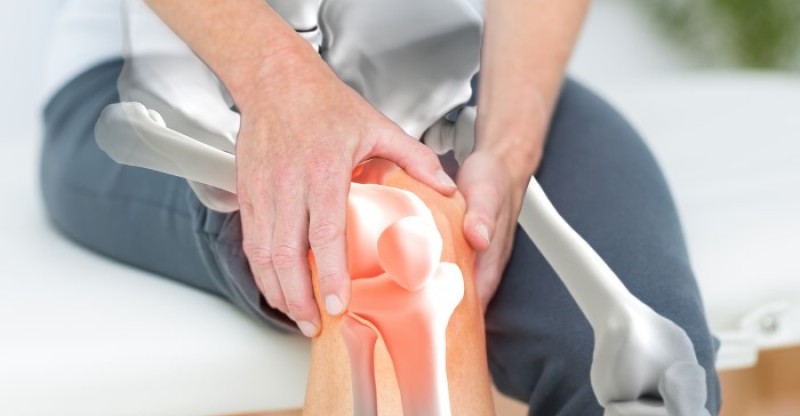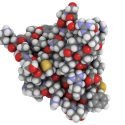16 Proven Natural Remedies for Joint Pain
As people age, their body naturally begins to decline.
One of the more troubling areas that decline as we age is our joints.
This can result in a host of physical issues which can range from the irritating to incapacitating.
Once our joints decline to a certain point, it can be difficult to do the everyday tasks and activities required for normal life.
Unfortunately, finding relief for these issues can be costly and time-consuming.
Thankfully, with a little knowledge, you can help treat and control your joint pain from the comfort of your own home.
First, it helps to know what causes joint pain in the first place.
Then, you should know how to prevent it before it even becomes a problem.
Of course, sometimes joint pain is unavoidable, especially for certain chronic conditions like arthritis.
That is why we have put together a list of home remedies for joint pain, so you can get back to doing the things you love — pain-free.
What is Joint Pain?
Not all causes of joint pain have the same effects, nor do all causes require the same type of treatment.
In order to address your joint pain properly, you must first recognize its cause.
Here are a few of the more common causes of joint pain.
Arthritis
This is actually a bit of a catch-all term for a number of different afflictions which each have their own unique causes.
However, all of these issues have one thing in common — joint pain.
The most common type of arthritis is osteoarthritis.
This is a natural condition that occurs as we age and the cartilage which protects the bones at the joints wears down.
Rheumatoid arthritis is another common form of the condition.
This is a chronic issue caused by an autoimmune disorder which mistakenly targets the body’s own tissues.
However, this condition targets the lining of the joints themselves, rather than the protective cartilage surrounding them.
Gout
Technically, gout is a complex form of arthritis.
However, its causes are distinct from the other forms and require an entirely different approach to achieve relief.
Unlike osteoarthritis, which is a natural condition as we age, or rheumatoid arthritis, which is an autoimmune response, gout occurs when there is too much uric acid in the body.
As the uric acid builds up, it begins to develop crystals which are then deposited in the joints, causing pain and inflammation.
The most common site of joint pain caused by gout is the big toe, but gout can affect the hands, wrists, ankles, knees, and feet in general, as well.
While gout can sometimes be caused by an inability of the kidneys to properly process uric acid in the blood, it can also be exacerbated by foods we consume.
Red meat, alcohol, and fruit sugars can all increase the level of uric acid in the bloodstream.
Sprains and Strains
Both of these injuries are similar in the cause but different in the tissues affected.
Basically, a sprain or a strain occurs when the corresponding tissue is stretched too far.
Sometimes this can cause the tissue to tear.
It is important to note that a sprain occurs at a ligament.
Ligaments are tough, fibrous bands of tissue that surround the connecting points of joints and bones.
Strains, on the other hand, occur at muscles and tendons generally where the tissues connect with each other, or where the tendon connects to the bone.
Mild strains and sprains can be treated at home without the need for medical assistance.
In this case, you would use the RICE method of treatment: rest, ice, compression, and elevation — in that order.
How to Avoid Joint Pain
The best way to get rid of joint pain caused by arthritis or injury is never to develop it in the first place.
While some pain may be unavoidable, there is a number of ways that you can work proactively ahead of time to prevent joint pain from becoming an issue.
Many of the methods to prevent joint pain coincide with the best habits of a naturally healthy lifestyle.
As such, if you simply take care of your body, your likelihood of joint pain will be reduced naturally.
Exercise
This can be a bit tricky depending on your condition, but proper exercise will still help prevent joint pain in many cases.
Keep in mind that the sources of joint pain cited, like arthritis, may limit your mobility, but you can and should still exercise to help reduce joint pain.
Some of the best forms of exercise for those with a chronic condition are low-impact exercises.
Water exercise, for instance, allows you still to get the benefits of movement and aerobic workouts without placing undue stress on your joints — a must for arthritis.
Nutrition
Much like exercise, nutrition can be a bit tricky when it comes to joint pain, because certain causes of joint pain, like gout, may be inflamed by some of the foods which are shown to ease joint pain from other causes, like arthritis.
In general, the best nutrition to help prevent joint pain will include the same foods necessary for a healthy body in general.
Specifically, fruits and vegetables are preferred over sugars, grains, meats, and dairy products.
However, people with gout should limit their intake of extra-sugary fruits as well.
Weight Loss
Every pound of weight on the human body exerts four pounds of pressure on the knee.
A similar effect occurs at the hip and ankle as well.
That is why losing weight can be an effective way of preventing certain types of joint pain caused by arthritis.
Moreover, losing weight is often a natural result of following the first two methods of preventing joint pain the in the first place: exercise and proper nutrition.
These can even benefit arthritis in the hands and wrists, as they will be less stressed by the surrounding tissues; this effect though may be less pronounced.
Natural Remedies for Joint Pain
Turmeric
Turmeric is a plant native to Southeast Asia that is part of the ginger family.
It has been used for centuries to season that region’s foods with a warm, peppery flavor.
As such it is fairly easy to introduce turmeric into your diet to help with arthritis pain relief.
Moreover, turmeric can be consumed in fairly large quantities without worrying about undesirable side effects, so you do not have to worry about careful dosages like with some other natural remedies.
In fact, turmeric has been used as one of many natural remedies for arthritis in the Ayurvedic medicine practice — a traditional health care practice that has its roots in India and includes Yoga, meditation, and massage.
Of course, not everyone finds the flavor of turmeric pleasant.
This is why you can also find supplements which include the active ingredient of turmeric, curcumin.
It is important to note that curcumin is an anti-inflammatory and not an analgesic, so be sure that you are treating the appropriate symptom.
Mouth Disinfectant
It may come as a surprise to you, but the health of your mouth can directly influence the health of other systems in your body.
Normally, this occurs when the pain in the mouth makes eating difficult and leads to malnutrition.
However, recent studies have found that bacteria in the mouth can migrate to different parts of the body as well.
Specifically, the bacteria responsible for gingivitis have been found in the synovial fluid, the fluid that joints use to lubricate movement, in patients with arthritis.
While this bacteria may not be responsible for your arthritis, it can still exacerbate or cause a bout of pain.
That is why you should disinfect your mouth regularly — beyond the general benefits of oral hygiene.
To avoid using alcohol-based mouthwash, you can simply mix water and baking soda as well as rosemary or lavender essential oils together.
Just be sure not to swallow the essential oils.
Massage
Massage has been used for centuries to help treat sore muscles, but it can also be a great form of treatment for joint pain as well — including joint pain caused by arthritis.
However, there are definitely some precautions that you need to be aware of before using massage as a way to help manage joint pain.
Specifically, there is a number of different types of massage, but not all of them are indicated for the treatment of joint pain.
For instance, deep tissue, myofascial release, and rolling are all types of massage that involve the use of intense pressure to achieve their result.
This pressure may be too much for weary joints, and simply cause more pain than it alleviates.
Therefore, if you seek a professional to provide joint pain relief with massage, they should probably use Swedish massage techniques which rely more on lighter pressure and longer strokes.
If you are able, you can also massage yourself, though this may be difficult for arthritis in the hands.
Exercise
As mentioned before, exercise can be a great way to help prevent joint pain from becoming an issue in the first place.
However, once joint pain begins, that does not necessarily mean that you should put off exercising until the pain goes away.
In fact, depending on how you do it, exercising during joint pain can actually help speed up the process of alleviating it.
Of course, this does not mean that all of the exercises you do to help prevent joint pain are the same ones you should do when it flares up.
Still, there is a fair amount of crossover such that many of the same exercises used for prevention can provide relief for arthritis and other types of joint pain.
The main thing to remember in this situation is to focus on low-impact exercises.
Swimming, yoga, and biking can all be effective means of exercise that do not place too much strain on already-inflamed joints.
Moreover, exercises that increase the range of motion can also help ease joint pain.
Ice
Ice can be a bit of a double-edged sword in this regard, depending on the cause of your joint pain.
For instance, if you have suffered from a sprain or strain and are experiencing joint pain, then ice is an appropriate form of treatment for a relatively short time.
After a day or two, ice will not be as effective.
This is because use causes the blood vessels to constrict, which ultimately reduces the amount of blood that the iced area receives.
However, this also makes ice a great way to help reduce joint inflammation without having to rely on over-the-counter medications.
You will want to take the ice or cold pack, and wrap it in a towel.
Never place ice directly on the skin for an extended duration as this can cause tissue damage.
Place the iced towel on the affected area and leave it there for 15 to 20 minutes.
Remove the ice and let the area get back to body temperature.
You can repeat this process every other hour for about a day before giving your body a chance to rest.
Epsom Salt
Epsom salt is a long-standing solution for joint pain relief that has been used for centuries around the world.
Oddly enough, Epsom salt was not initially used for pain relief, and instead saw its first use as a laxative.
However, it was not long before the anti-inflammatory benefits of Epsom salt were observed, and its use for pain relief realized.
It is important to note that Epsom salt does not work via the same mechanism as many other anti-inflammatories which seek to constrict the blood vessels to prevent swelling and inflammation of the surrounding tissues.
Instead, Epsom salt works by leaching excess fluids from the affected area.
To use Epsom salt baths for joint pain, you will want to make sure that you use warm water, not hot water.
Hot water will cause your blood vessels to expand and may make the inflammation worse.
Soak the pained joint in the water for 15 minutes, or until the water cools.
If desired, you can repeat the process a few times.
Magnesium
Since we covered Epsom salts, it is probably a good idea to mention the virtues of magnesium itself.
Keep in mind, Epsom salt is actually magnesium sulfate, and the water causes the bonds in Epsom salt to dissolve into simply magnesium and sulfur.
However, oral magnesium presents a different solution to the same problems.
While we mentioned that nutrition is a great way to help prevent joint pain in the first place, oral magnesium may be one of the best natural remedies for arthritis for a few reasons.
First, magnesium is not only a vital component in a variety of body systems, but it plays an important role in the strengthening and maintenance of both bones and cartilage.
For those seeking relief from osteoarthritis, ensuring that your body has the necessary nutrients to maintain itself is crucial.
While there are plenty of supplements out there which offer magnesium, you can easily get this nutrient in your diet by simply eating various seeds and nuts.
Extra Virgin Olive Oil
Extra virgin olive oil, or EVOO, has been used for cooking in the Mediterranean region for centuries.
Aside from being an excellent cooking oil, it has also been demonstrated to provide a number of health benefits, including its high concentration of antioxidants and oleic acid which can have a beneficial effect on cancer-linked genes.
However, for arthritis and other forms of joint pain, extra virgin olive oil also offers some other benefits.
For one, it can help lubricate your joints, which is especially beneficial to most types of arthritis.
Moreover, it acts as an anti-inflammatory in the same way as over-the-counter medications — so much so that it can rival low doses of Advil or aspirin.
You can take extra virgin olive oil, consuming 2 to 3 tablespoons a day, or you can massage the oil directly into your joints.
Just be sure you purchase a high-quality extra virgin olive oil, or else you may not receive the desired benefits from a product lacking, or with a low concentration of, the active ingredients.
Hydrotherapy
While Epsom salt baths are one of the best home remedies for arthritis, you do not necessarily need the Epsom salts to achieve those results.
In fact, hydrotherapy is an excellent treatment for arthritis pain relief that you can use in the comfort of your own home.
However, there are diffused and targeted ways of doing this.
The general approach for using hydrotherapy is simply immersion of the affected area in warm water.
For some types of joint pain, like those caused by arthritis in the hands, or gout in the feet, this can be accomplished with little additional fuss beyond a medium-sized plastic container.
However, shoulders, hips, and knees may require a full bath to immerse the area properly.
Of course, the other form of hydrotherapy involves the use of jets of water to massage targeted points on the body.
This will often require the use of a thin plastic sheet and does not actually rely on the water being in direct contact with the skin or affected area.
Of course, not everyone will have the proper tools to do this at home.
Blackstrap Molasses
In the long list of home remedies for arthritis, few will be able to beat blackstrap molasses.
Keep in mind, this is not to suggest that blackstrap molasses are strikingly more successful than the other methods on our list, though it does provide plenty of benefits.
No; instead, blackstrap molasses is one of the best remedies for joint pain, because it works and is otherwise enjoyable.
Many of the methods on this list require you to take time and energy out of your day and do tasks that are not part of your normal routine.
However, if you are one of the millions of people who starts their day with a fresh cup of coffee, a tablespoon of blackstrap molasses can be an excellent way to sweeten your coffee and help relieve arthritis.
Moreover, blackstrap molasses works the same way a couple of the other remedies do: through magnesium.
However, blackstrap molasses also contains plenty of calcium and potassium — both of which are necessary for conjunction with magnesium for healthy joints and bones.
Essential Oils
The list of essential oils and their various health benefits is a long one indeed.
However, not every essential oil will provide the same benefits.
As mentioned previously, rosemary and lavender can be effective as part of a mouth disinfectant.
However, the number of essential oils which can help alleviate pain and reduce inflammation is many.
Keep in mind, you will want to make sure you are treating the proper symptom.
For instance, chamomile oil will work as both an analgesic and an anti-inflammatory.
However, lavender only works as an analgesic, while peppermint oil will only function as an antispasmodic and an anti-inflammatory.
Since you should not consume essential oils, the two most popular methods of application are either in a bath or in an oil.
Both of these work via the similar principle of being absorbed through the skin, but they require different preparation.
For the oil, simply add a couple drops to a carrier oil like a nut- or vegetable-based oil.
Cod Liver Oil
Cod liver oil is another substance that carries with it a litany of health benefits that extend well beyond the realm of assisting with joint pain.
It can help prevent macular degeneration, as well as coronary atherosclerosis.
Moreover, it contains relatively high amounts of both vitamin A and vitamin D.
The latter vitamin is an important component assisting in calcium absorption for bone development.
However, the primary benefit of cod liver oil is the high amount of omega-3 fatty acids that it contains.
These compounds act as a general anti-inflammatory, but they have demonstrated an especially beneficial effect on people with rheumatoid arthritis.
Cod liver oil is most commonly taken as a supplement, though you can also find a liquid version.
If taking the liquid version, two teaspoons a day is an appropriate dosage.
One thing to keep in mind is that not all manufacturers of cod oil use fresh ingredients.
This can decrease the potency and is responsible for “fishy burps.”
Cayenne ‘Capsaicin’ Ointment
While a majority of the remedies for joint pain on this list has focused either on strengthening and rebuilding joints, or functioning as an anti-inflammatory, far fewer have presented as an analgesic that will actually stop the pain when it starts.
This is where a capsaicin ointment can come into play.
Pain operates via a neurotransmitter called substance P to send signals from the nerves to the brain.
Most analgesics interrupt this transmission in some way — whether at the source of the nerve, along with its path, or at the brain.
Capsaicin has been shown to inhibit the neurotransmitter substance P itself, preventing the signal from firing in the first place.
While it is technically possible to consume capsaicin, that is also the ingredient in peppers that gives them their spicy flavor — which would make for a fairly uncomfortable ingestion.
Instead, people often use a “hot pepper cream” which you can make at home with cayenne pepper and some other ingredients.
Ginger
Ginger is another solution for joint pain that also falls into the category of an herb that people commonly use to season their food and occasionally just eat.
In fact, slivers of ginger are often used as a palate cleanser between courses of a large meal to clean out the flavors of the previous dish and enhance the flavors of the next one.
Ginger’s mechanism of action relies on both gingerols and its own essential oils — which are safe to eat as part of the root, but not in an extracted, concentrated form.
These ingredients have anti-inflammatory effects in general, but they show marked promise for people who have arthritis — particularly rheumatoid arthritis.
While it is perfectly safe simply to eat the ginger root, the flavor may be a bit too strong for some people.
An alternative method of consumption that will tame the flavor a bit is to brew ginger root tea.
Of course, you can also use it as a seasoning for other food.
Glucosamine – Chondroitin – Quercetin Combo (GCQG)
This is another method of treating joint pain that is a bit limited in its approach.
The value of GCQG has been shown in scientific studies, but the way that it works holds more benefits for people who suffer from osteoarthritis than other forms of joint pain, due to the fact that it can help rebuild the cartilage around joints.
However, this is not truly a single substance but is instead a combination of ingredients.
Specifically, glucosamine and chondroitin are the two ingredients that have been shown to help improve joint health, and thus reduce pain.
However, when glucosamine and chondroitin are combined with quercetin, their effects seem to be enhanced as though catalyzed.
Unfortunately, there is no natural way to take GCQG.
If you want to use this product, you will have to purchase it as a supplement.
As with all supplements, do your homework to make sure the manufacturer uses high-quality ingredients and third-party verified manufacturing processes.
Gelatin
Most people will think of various types of food when they hear the word “gelatin,” but these days you are just as likely to find gelatin in medication or supplements as in food.
While its use in marshmallows, yogurts, and ice cream is well-known — not to mention in semi-translucent gelatin desserts — its use for joint relief still flies under the radar.
Gelatin will not be the right solution for all people who suffer from joint pain, but for some, gelatin will work specifically on the cause which afflicts them.
Specifically, gelatin can be an effective way to reduce joint pain for people who have osteoarthritis.
This is because gelatin is literally derived from collagen, and so has been shown to help rebuild collagen for those with a deficiency.
The easiest way to take gelatin is to mix it in with other foods.
Smoothies or other blended beverages offer a convenient method of doing so.
Just remember not to heat up the gelatin, or it will lose its potency.
Conclusion
As we can see, arthritis and other forms of joint pain are not something you simply have to resign yourself to dealing with.
If you take a little time to understand how the entire process functions, you can empower yourself to take charge of your joint pain and battle it head-on, rather than being its victim.
One of the first steps in dealing with joint pain is recognizing its causes.
Some of the most common forms of joint pain occur with arthritis.
However, even arthritis is not a single problem, as its source can arise from age, an autoimmune response, a buildup of contaminants, and even an acute infection.
Moreover, one of the best ways of relieving joint pain is to prevent it from occurring in the first place.
While this is not necessarily a foolproof solution, engaging in a healthy lifestyle that includes a proper diet combined with low-impact exercise and a weight loss regimen can drastically improve your joint health and help reduce pain.
Of course, for some of the causes of joint pain, an occasional flare-up is inevitable.
In that instance, it is important to recognize whether the pain is caused by inflammation or not.
If joint inflammation is the source, then an anti-inflammatory is the remedy.
However, if inflammation is not an issue, you should seek an analgesic to help with pain relief.
Regardless of the source of your joint condition, or the actual type of pain you are dealing with, our list of remedies offers numerous avenues to tackle the tough task of alleviating joint pain.
With a solid understanding and the right materials, you can handle the joint pain from the comfort of your own home.
FDA Compliance
The information on this website has not been evaluated by the Food & Drug Administration or any other medical body. We do not aim to diagnose, treat, cure or prevent any illness or disease. Information is shared for educational purposes only. You must consult your doctor before acting on any content on this website, especially if you are pregnant, nursing, taking medication, or have a medical condition.
HOW WOULD YOU RATE THIS ARTICLE?






